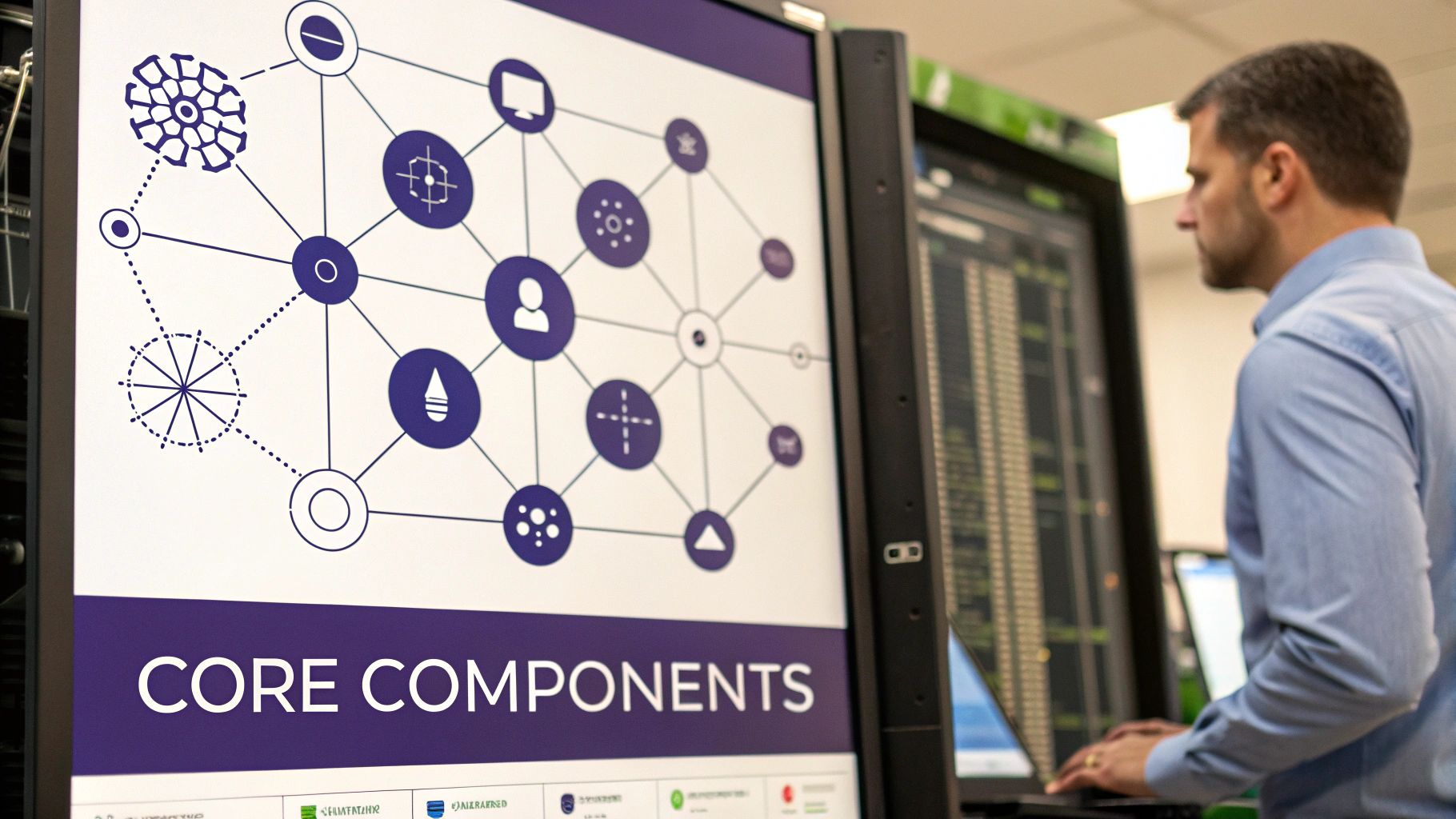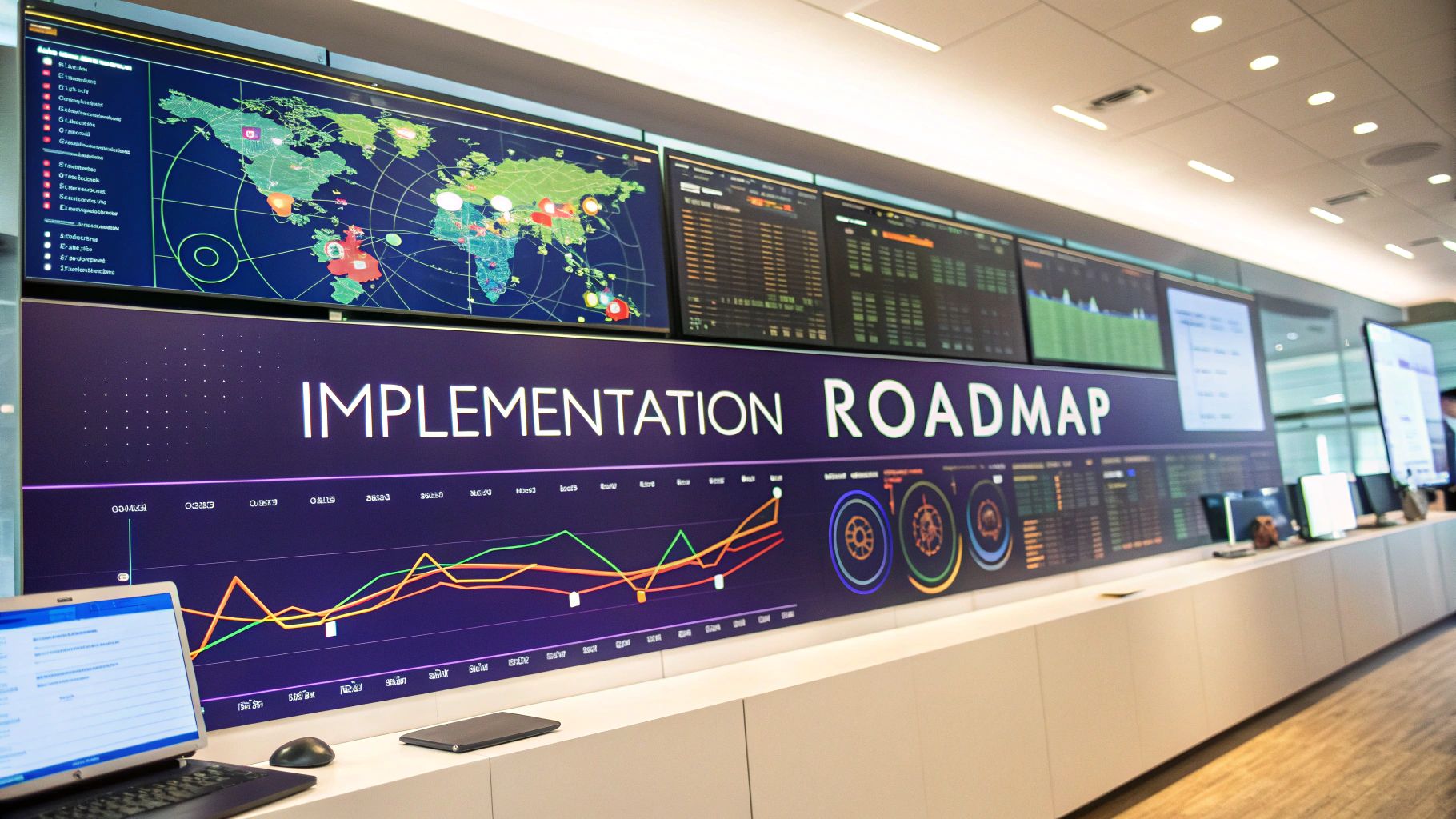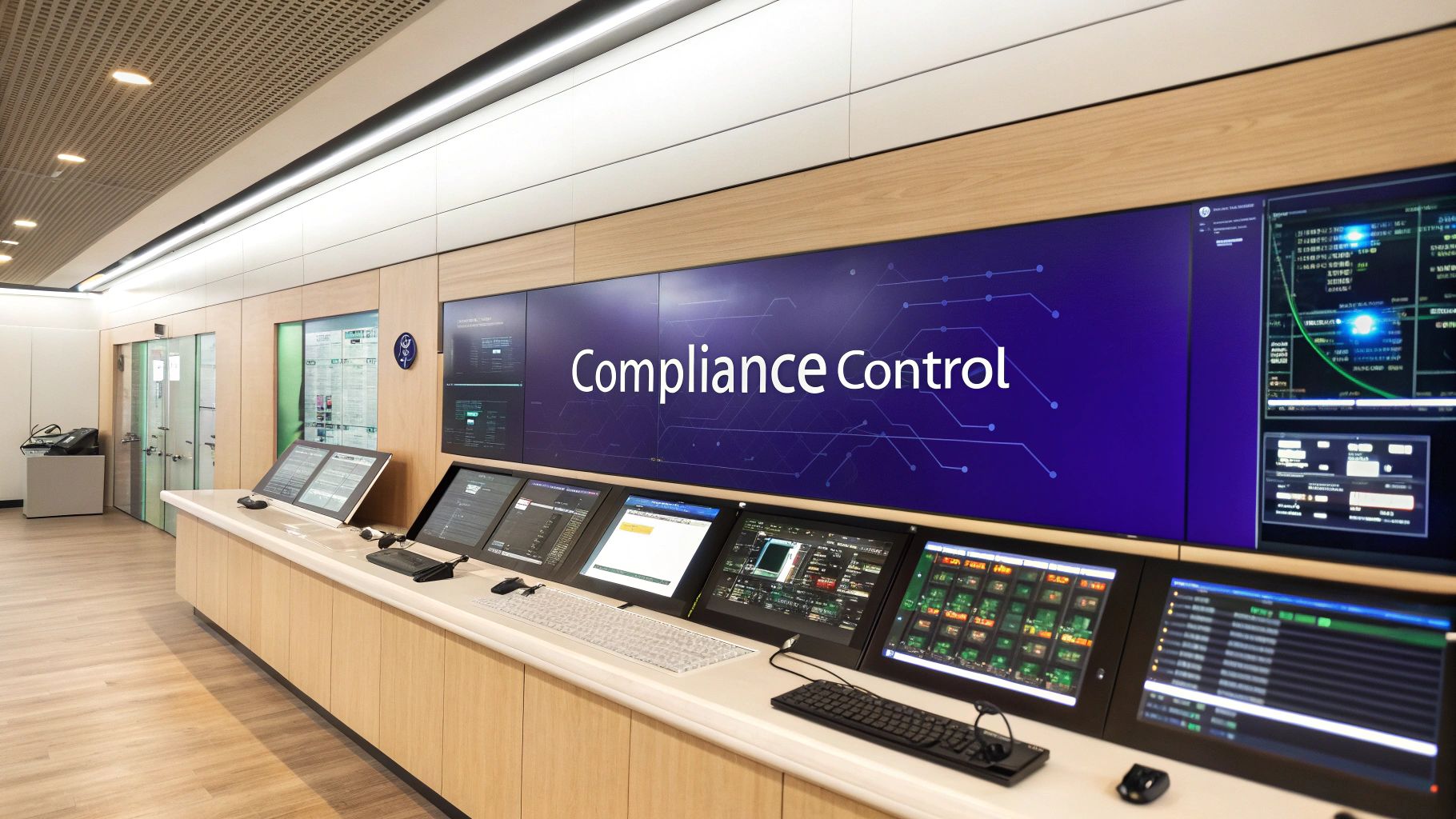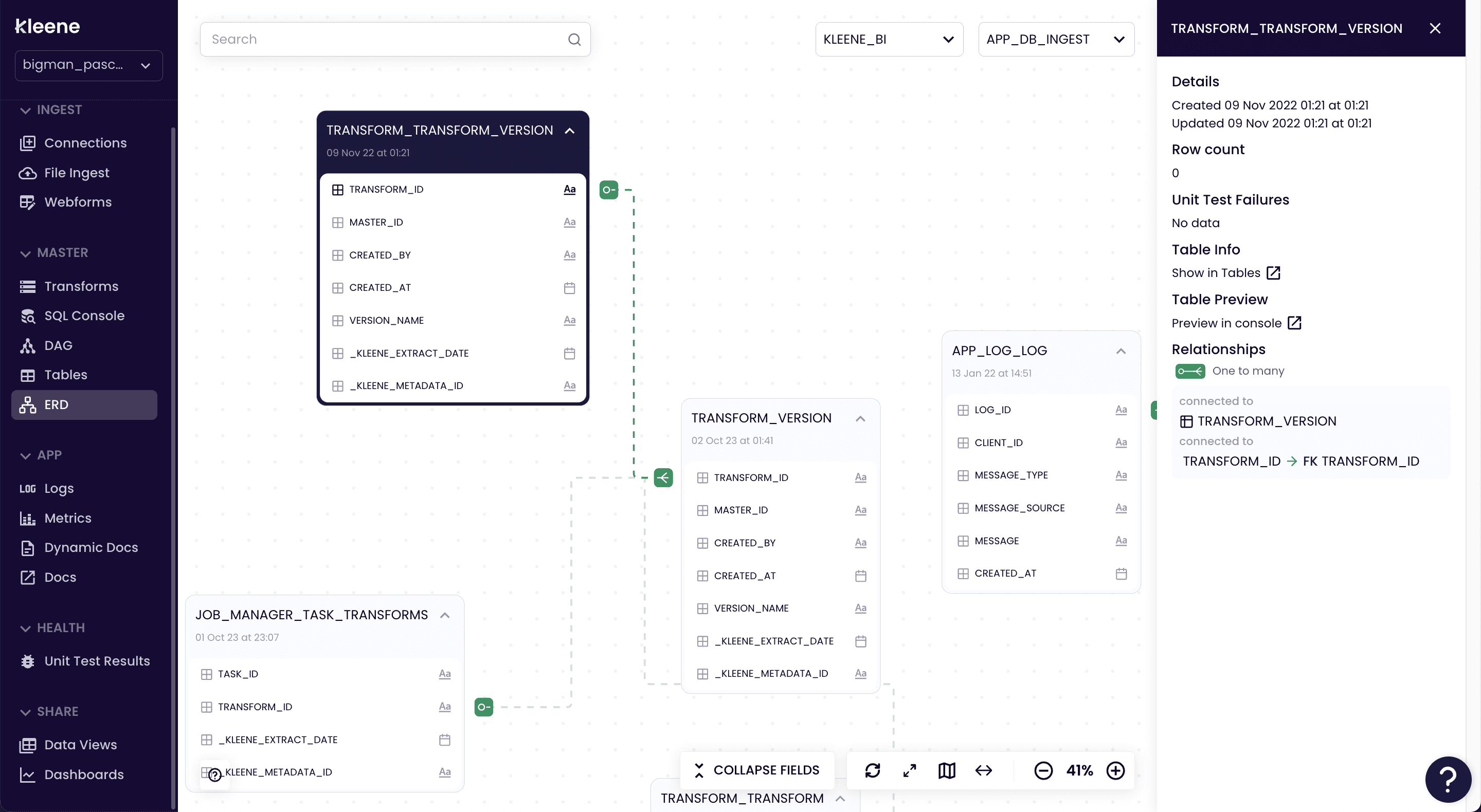The Foundation: Why Your Data Governance Framework Matters

Many organizations are awash in data, yet struggle to derive meaningful insights. This often stems from a lack of effective data governance. A data governance framework template provides the blueprint for managing data as a valuable asset. Simply having a template isn't enough, though. Organizations must understand the principles of good governance to truly benefit.
A robust framework goes beyond simple compliance. It establishes clear processes for data quality, accessibility, and security. For instance, it defines who owns specific data, its permitted uses, and who ensures its accuracy. This clarity is essential for informed decisions and avoiding costly errors. A solid framework also allows organizations to adapt to changing business needs and regulations. For further insights, check out this resource: How to master your data maturity.
Key Benefits of a Strong Data Governance Framework
A strong data governance framework provides numerous advantages:
- Improved Data Quality: Standards and processes ensure data accuracy and consistency.
- Enhanced Decision-Making: Reliable data leads to better decisions at all levels.
- Reduced Risk: A well-governed data environment minimizes risks like breaches, fines, and reputational damage.
- Increased Efficiency: Streamlined processes and improved accessibility boost efficiency.
- Better Compliance: A robust framework helps ensure compliance with regulations like GDPR.
In the UK, the importance of a data governance framework template is highlighted by the need to comply with GDPR. UK public sector entities have been actively developing tailored frameworks, using the UK Government's framework as a guide. This helps avoid legal issues and maintain public trust. The ICO (Information Commissioner's Office) plays a key role, with fines for non-compliance reaching up to £17 million or 4% of global turnover. Learn more about UK data governance frameworks.
Building a Framework That Works
Building a successful framework requires a strategic approach. This involves understanding organizational needs, defining roles and responsibilities, and establishing communication channels. The framework must also remain flexible and adaptable to evolving business requirements. This adaptability is crucial in our dynamic data landscape.
A practical framework needs a strong foundation. It establishes the structures and processes to ensure data is treated as a valuable asset. This foundation improves decision-making and contributes to overall business success, setting the stage for effective data management throughout its entire lifecycle.
Critical Components That Make or Break Your Framework

A data governance framework template provides a solid starting point. However, its true effectiveness depends on several key components. These components are what transform data governance from a perceived burden into a valuable driver of business value. This transformation involves structuring data ownership, promoting data stewardship, and implementing quality standards that yield measurable results.
Defining Data Ownership and Stewardship
Clear data ownership is crucial. Just like assigning responsibility for physical assets, clear data ownership clarifies who is accountable for the accuracy, accessibility, and security of specific data. This accountability ensures data is handled with the care and attention it deserves. Effective data stewardship supports data owners. Stewards provide expertise and guidance, acting as subject matter experts who understand the nuances of specific data domains.
Establishing Clear Roles and Responsibilities
A well-defined governance structure brings clarity to decision-making processes. Governance committees are instrumental in balancing centralized oversight with the necessary departmental autonomy. This ensures consistent data management across the entire organization. These committees, often composed of representatives from different departments, bring diverse perspectives to the table.
They also provide a valuable forum for discussing data-related challenges and opportunities. This collaborative approach fosters a shared understanding of data's importance within the organization. Well-defined escalation paths for conflict resolution are essential. These ensure timely and effective responses to any data-related issues that may arise. Additionally, robust accountability mechanisms reinforce the importance of adhering to established data governance procedures.
For example, the British Business Bank offers a practical example of a successful data governance framework. As of May 2023, they implemented a Data Governance Standard across all their entities. This standard focuses on ownership, stewardship, and operational structures. Their framework incorporates three levels of forums and working groups to streamline decision-making. This initiative aims to improve data quality and reduce risks, targeting a 95% compliance rate by the end of 2024.
Implementing Data Quality Standards
Data quality forms the cornerstone of effective governance. Without accurate and reliable data, decision-making is compromised. Data quality standards provide a benchmark for assessing data accuracy, completeness, and consistency. These standards should always align with the specific needs of the business.
This alignment ensures the data is fit for its intended purpose. Regular data quality assessments are vital. They identify areas for improvement and track progress over time. This consistent focus on quality builds trust in the data, supporting data-driven decision-making across the organization.
Adapting to Organizational Culture
Successful frameworks align with the existing organizational culture. This involves recognizing existing data practices, communication styles, and established decision-making processes. Governance shouldn’t be imposed; it should be integrated. A framework that complements the organizational culture will encounter less resistance and encourage wider adoption.
Some organizations might benefit from a centralized governance model. Others might thrive with a more decentralized approach. Understanding these nuances is key to successful implementation.
The following table outlines the core components of a data governance framework template. It also explains the purpose and significance of each element.
Essential Data Governance Framework Components
| Component | Purpose | Implementation Considerations | Success Indicators |
|---|---|---|---|
| Data Ownership Model | Clarifies responsibility for data assets. | Define clear ownership roles and responsibilities. | Improved data accuracy and accountability. |
| Data Stewardship Program | Provides expert guidance on data management. | Establish a network of data stewards. | Enhanced data quality and consistency. |
| Data Quality Standards | Define acceptable levels of data accuracy and completeness. | Align standards with business requirements. | Reduced data errors and improved decision-making. |
| Governance Committees | Oversee data governance activities and decision-making. | Balance central control with departmental needs. | Effective data governance policies and procedures. |
| Escalation Paths | Provide clear processes for resolving data-related conflicts. | Establish clear reporting lines and procedures. | Timely resolution of data issues. |
| Accountability Mechanisms | Ensure adherence to data governance policies and procedures. | Implement clear consequences for non-compliance. | Improved compliance with data governance rules. |
By incorporating these elements, a data governance framework becomes a vital tool. It allows organizations to manage data effectively. This creates a strong foundation for informed decision-making and drives business success. This also lays the groundwork for the operational aspects of implementing the framework, which we'll discuss in the next section.
Crafting Your Operating Model: From Theory to Practice

A data governance framework template provides a solid foundation. However, the true test lies in its practical application within your organization. This means creating an operating model that works within existing limitations. This section offers practical strategies for turning governance principles into actionable steps.
Establishing Governance Roles and Responsibilities
Clearly defined roles are essential, but avoid creating unnecessary overhead. Instead of establishing entirely new positions, consider integrating governance responsibilities into existing job descriptions. This approach prevents organizational bloat while ensuring accountability. It also provides opportunities for professional development within your existing team.
Well-defined roles promote clarity and ownership, contributing to a more efficient governance structure. This clarity also facilitates measuring the effectiveness of each role within the framework.
Furthermore, clear roles contribute to effective decision-making processes. These processes should streamline operations, not hinder them. Documented workflows and clear approval hierarchies are crucial for achieving this agility.
The UK's National Data Strategy highlights the importance of data governance for effective data sharing. Launched in 2020, this strategy seeks to improve data sharing across government departments. The Data Sharing Governance Framework, published in 2022, offers key principles for consistent data governance. This framework serves as a valuable resource for government leaders and data specialists. By 2025, it aims to improve data sharing efficiency, with a target of making over 80% of government data shareable.
Balancing Centralized Governance and Distributed Execution
Successful organizations find a balance between centralized oversight and distributed execution. A central governance body provides overall direction and ensures consistency. However, allowing individual departments to adapt the framework to their specific needs encourages ownership and relevance.
This adaptable approach promotes efficient resource allocation. Resources should be prioritized based on governance needs. This ensures maximum impact from investments in data governance initiatives.
Communication and Collaboration
Open communication is key to successful data governance. Regular updates, training, and feedback mechanisms keep everyone informed and engaged. Transparency builds trust and confidence in the framework. This open communication fosters a collaborative environment.
For further insights, check out this resource on implementing data systems.
Technology and Tools
The right technology can significantly improve governance processes. Tools for data quality monitoring, metadata management, and access control automate tasks and enhance efficiency. Automating routine tasks frees up time for strategic initiatives, allowing data governance professionals to focus on higher-value activities. Careful evaluation is essential for selecting the right tools.
Accountability and Measurement
Establish clear accountability mechanisms with consequences for non-compliance. This ensures the framework is actively applied, not just a theoretical document. These mechanisms also provide a structure for measuring success, which is crucial for demonstrating the value of data governance.
By integrating these elements, organizations move from theory to a practical operating model. This practical approach delivers tangible benefits, ensuring that data governance contributes real value. This model forms the foundation for sustainable data governance practices.
Implementation Strategies That Actually Work

Many data governance initiatives fail during implementation. Successfully transitioning a data governance framework template into a working system requires more than planning. It requires careful execution and continuous adaptation. This section explores practical strategies to help you move from planning to practice. These are based on insights from successful data governance implementations.
Securing Executive Sponsorship and Buy-In
True executive sponsorship is essential. This involves more than just verbal support. It requires active participation and the allocation of necessary resources. Demonstrating the potential return on investment (ROI) of data governance is key. Quantify potential cost savings from fewer data errors. Showcase potential revenue gains from improved decision-making.
Securing buy-in across different departments is also crucial. Involve stakeholders from various departments in the implementation process. This collaborative approach ensures the framework addresses everyone's needs. It considers everyone who interacts with data.
Demonstrating Early Wins
Early successes build momentum. They reinforce the value of data governance. Focus on achievable projects with high impact. Choose projects that deliver tangible results quickly. For example, improving data quality in a key business area showcases immediate benefits. These wins build trust and encourage wider adoption across the organization. This positive feedback strengthens the overall data governance initiative. For further insights, explore resources on handling data silos.
Overcoming Resistance and Embedding Governance
Resistance to change is unavoidable. Openly and transparently address concerns. Clear communication is crucial. Explain the benefits of data governance. Describe how it will impact individual roles.
Integrate data governance into existing workflows. Make it a natural part of how people work. This might involve embedding data quality checks into current systems. It could also include integrating data governance into project management.
Phased Implementation and Communication
A phased approach helps manage the complexity of data governance. It allows for adjustments throughout the process. Start with a pilot project in a specific area. Then, roll out the framework across the organization. This allows for testing and refinement in a controlled setting.
Tailor communication to resonate with different stakeholders. Use various methods. Executive summaries provide high-level overviews. Detailed reports offer in-depth information. Interactive training sessions can cater to specific learning styles.
Measuring Progress and Demonstrating Value
Regular monitoring and evaluation are vital. Track key metrics. This might include data quality improvements, error reduction, and cost savings. Communicate these results to stakeholders. This reinforces the value of data governance and secures ongoing support.
The following table offers a roadmap for implementing data governance. It highlights key activities, timelines, success criteria, and potential challenges for each phase.
Data Governance Implementation Roadmap
The table below provides a phased approach to implementing a data governance framework. It outlines key activities and milestones for each stage.
| Implementation Phase | Key Activities | Timeline | Success Criteria | Common Challenges |
|---|---|---|---|---|
| Planning and Design | Define scope, objectives, roles, and responsibilities. | 2-3 months | Documented framework and stakeholder buy-in. | Lack of clear objectives, resistance to change. |
| Pilot Implementation | Implement the framework in a limited scope. | 1-2 months | Demonstrated success in the pilot area. | Limited resources, technical difficulties. |
| Expansion and Rollout | Expand implementation to other areas of the organization. | 3-6 months | Increased data quality and improved decision-making. | Communication gaps, lack of training. |
| Monitoring and Evaluation | Track key metrics and make adjustments as needed. | Ongoing | Continuous improvement and demonstrable ROI. | Data silos, inconsistent data definitions. |
Implementing these strategies allows organizations to effectively implement a data governance framework. This transforms a template into a working system that provides real business value. This structured approach then allows for accurate measurement of the framework's success.
Measuring Success Beyond Compliance Checkboxes
Data governance isn't just about checking off compliance requirements. It's about creating real business value. This means moving beyond simply having a data governance framework template and focusing on how it drives positive change within your organization. This section explores how successful governance programs measure their impact in ways that resonate with business leaders.
Connecting Governance to Business Outcomes
Effective measurement frameworks directly link governance activities to the outcomes executives care about. This could include anything from better decision-making and improved customer experiences to lower operational costs and increased revenue.
For example, tracking how improved data quality impacts customer retention provides a clear connection between governance and business value. Similarly, measuring the reduction in time spent on data cleansing demonstrates how governance contributes to operational efficiency. Read also: How to master your single source of truth.
Tracking Data Quality Improvements
Data quality is essential for successful governance. Practical approaches to tracking improvements involve establishing key metrics like data completeness, accuracy, and consistency.
Regular data quality assessments pinpoint specific areas where governance has made a difference. This might include a decrease in data errors or an increase in the completeness of important datasets. These quantifiable results offer concrete evidence of governance effectiveness.
Measuring Operational Efficiency Gains
Data governance can significantly impact operational efficiency. By streamlining data processes and making data more accessible, governance initiatives can save time and resources.
Track metrics like the time spent on data-related tasks or the number of manual interventions needed. For example, if a new data governance process reduces report preparation time by 50%, this tangible improvement clearly demonstrates the framework's value.
Demonstrating Risk Reduction
Data governance frameworks play a crucial role in reducing risks. This includes regulatory risks, security breaches, and reputational damage from inaccurate data.
Measuring risk reduction can involve tracking the number of data breaches prevented or the decrease in regulatory fines. Another key metric is the improvement in data security posture, perhaps reflected in fewer security vulnerabilities found during audits. These measurable outcomes reinforce the framework's value in mitigating organizational risk.
Maturity Assessments and Benchmarks
Mature governance programs regularly conduct maturity assessments. These assessments provide a snapshot of the organization's progress in implementing data governance practices. They pinpoint areas for improvement and offer a roadmap for future development.
Establishing industry benchmarks lets organizations compare their performance with their peers. This comparison provides insights into best practices and highlights areas where the organization excels or needs to improve. This process supports continuous improvement and ensures the framework remains relevant.
Continuous Feedback and Evolution
Data governance isn't a one-time project. Implement continuous feedback loops to help governance practices evolve with changing business needs.
Regular framework reviews, combined with input from stakeholders across the organization, ensure its ongoing effectiveness. This adaptable approach guarantees the framework continues delivering value in a dynamic business environment. By focusing on these measurable outcomes, organizations can demonstrate the true value of their data governance framework, transforming governance from a compliance exercise into a strategic asset. This shift is crucial for securing continued support and resources for data governance initiatives.
Tailoring Your Data Governance Framework: A Custom Approach
A data governance framework template offers a solid foundation, but it's not a one-size-fits-all solution. Just as every business has its own unique structure and goals, its data governance framework must be tailored to fit its specific context. This ensures the framework is effective and adds value to the organization.
Assessing Your Organization's Specific Needs
Begin by understanding your organization's specific needs and characteristics. Consider the regulatory environment. Healthcare organizations, for example, must adhere to HIPAA, while financial institutions navigate regulations like GDPR. Data complexity also matters. A company dealing with large volumes of unstructured data will have different needs than one primarily working with structured data. Finally, consider your organizational culture. A hierarchical structure might require a more centralized approach to governance.
Evaluating Current Data Management Practices
Before making changes, assess your current data management practices. Identify your strengths and weaknesses. Do you have clear data ownership? Are data quality standards consistently applied? Understanding your current state helps pinpoint areas for improvement and informs the development of realistic implementation plans. For example, if data quality is a weakness, your framework should prioritize improving data validation and cleansing. You might find this resource helpful: How to master ERDs.
Prioritizing Critical Requirements
Not all components of a framework are equally important. Prioritize the elements that directly support your business objectives. If regulatory compliance is a top priority, focus on elements related to data security and access control. Other features, while potentially useful, may be secondary if they don't directly contribute to your immediate goals. This focused approach keeps your framework relevant and prevents it from becoming too complex.
Developing a Phased Implementation Roadmap
Implementing a complex framework all at once can be challenging. Instead, create a phased implementation roadmap. Start with a pilot program in a specific department. This allows you to test and refine the framework in a controlled environment. Once successful, expand to other areas, gradually building momentum and demonstrating value.
Balancing Standardization and Flexibility
Consistency is important, but allow for flexibility within the framework. Different departments may have unique data needs. A rigid approach can stifle innovation. For example, a marketing team's data requirements will differ from those of the finance department. Allow them to tailor the framework to their needs while still adhering to core governance principles.
Establishing Clear Governance Boundaries
Define clear governance boundaries within your organization. Clarify which data falls under the framework and which doesn't. Data used for highly sensitive operations, for instance, might require more stringent controls than data used for routine reporting. This clarity prevents confusion and ensures the framework is applied appropriately.
Evolving Your Framework Over Time
Data governance is not a one-time project. As your organization's capabilities mature and business needs change, your framework should evolve too. Regularly review and update the framework to ensure it remains aligned with your goals and incorporates industry best practices. This also allows you to include feedback from stakeholders, keeping the framework relevant and effective.
Future-Proofing Your Data Governance Framework
The world of data governance is constantly evolving. New technologies and regulations emerge regularly, requiring organizations to adapt their governance strategies. Building a future-proof data governance framework means creating a structure that can handle these changes without needing constant overhauls.
Adapting to Emerging Technologies and Regulations
New technologies like Artificial Intelligence (AI) and Machine Learning (ML) present unique governance challenges. Learn more about AI and Machine Learning on Wikipedia. Ensuring algorithmic transparency and addressing data ethics are critical. A future-proof framework should incorporate these considerations. Evolving regulations also demand attention. A flexible framework allows for necessary adjustments without major disruption, ensuring ongoing compliance.
Establishing Governance Review Cycles
Regular reviews are vital for any future-proof framework. Leading organizations establish cycles, often annually or biannually. These reviews assess the framework’s effectiveness, identify areas for improvement, and incorporate lessons learned. This keeps the framework relevant and aligned with business objectives. It also allows for adjustments based on stakeholder feedback.
Developing Capability Development Roadmaps
A capability development roadmap outlines the necessary skills and resources for effective data governance. This might include training for data stewards, investment in new technologies, or developing specialized expertise in data ethics. By proactively planning for future needs, organizations ensure they have the right capabilities to support evolving governance requirements.
Building Flexible Governance Structures
Rigid frameworks can hinder innovation. Future-proof frameworks prioritize flexibility. This might involve modular components adaptable to different data domains or flexible decision-making processes that accommodate new data sources and analytical methods. For example, when adopting cloud-based data storage, the framework should address the specific governance challenges of this environment.
Scanning the Horizon and Prioritizing Requirements
Staying ahead requires constant vigilance. Effective governance involves actively scanning for emerging trends and technologies. This might involve attending industry conferences, monitoring regulatory developments, or engaging with data governance experts. Prioritize these emerging requirements based on their potential organizational impact. This proactive approach allows for anticipating challenges and adapting governance practices.
Evolving Governance Practices Without Sacrificing Control
Adaptability is key, but maintaining data control remains paramount. Organizations must balance flexibility and control. This might involve establishing clear boundaries for data access and usage while still allowing for experimentation and innovation within those boundaries. For example, data sandboxes can provide secure environments for testing new analytical methods without compromising production data.
By adopting these strategies, organizations build data governance frameworks that meet today’s needs and adapt to future challenges and opportunities. This future-proof approach ensures data remains a valuable asset, driving informed decision-making and long-term success.
Ready to elevate your data governance? Kleene.ai offers a decision intelligence platform that empowers businesses to transform data into actionable insights. With a suite of AI-powered applications, seamless data integration, and expert consulting services, Kleene.ai helps unlock the full potential of your data. Visit Kleene.ai today to learn more.



